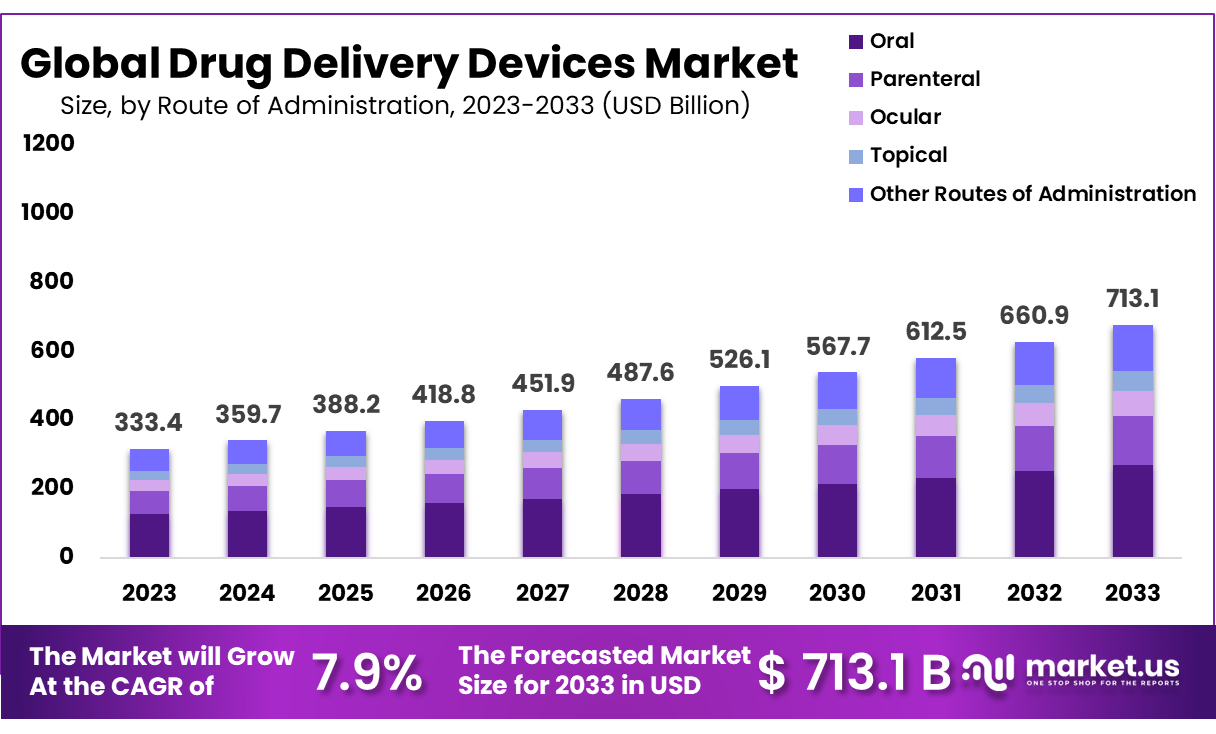New York, NY – June 16, 2025 – The global drug delivery devices market is expected to reach US$ 713.1 billion by 2033, up from US$ 333.4 billion in 2023. This growth reflects a compound annual growth rate (CAGR) of 7.9% from 2024 to 2033. The rising incidence of chronic diseases such as diabetes, cancer, and cardiovascular conditions is a key factor driving demand. These conditions require long-term treatment, increasing the need for efficient and user-friendly drug delivery solutions. Technological advancements are also transforming the landscape, making drug administration safer and more effective.
Innovative delivery technologies like smart inhalers, wearable injectors, and implantable systems are changing how patients manage their health. These devices support accurate dosing and reduce the burden on healthcare providers. Their ability to improve medication adherence and therapeutic outcomes makes them valuable tools in modern care settings. Patients increasingly prefer devices that allow self-administration, especially for chronic treatments, enhancing convenience and reducing hospital visits. This shift is expected to further boost market demand over the coming years.
North America currently dominates the global drug delivery devices market, driven by advanced healthcare infrastructure and high adoption of innovative medical technologies. However, the Asia-Pacific region is emerging as the fastest-growing segment. This growth is fueled by expanding healthcare access, rising chronic disease prevalence, and improved patient awareness. Countries like China and India are witnessing increased healthcare investments and reforms, providing a strong base for market expansion. As a result, manufacturers are focusing more on these regions for future growth opportunities.
Biologics and personalized medicine are creating new avenues within the drug delivery landscape. These treatments often require specialized delivery methods, which traditional systems cannot provide. As the focus shifts toward tailored therapies, demand for advanced drug delivery devices will continue to rise. Leading market players are investing in R&D to develop more precise and patient-friendly systems. Strategic collaborations and partnerships are also on the rise, enabling companies to combine innovation with scalable manufacturing.

Key Takeaways
- Market Outlook: The global drug delivery devices market is projected to hit US$ 713.1 billion by 2033, indicating strong future growth across various healthcare sectors.
- Advancements in Precision: Recent years have seen rapid improvements in drug delivery precision, enhancing how medications are administered for better therapeutic outcomes.
- Focus on Targeted Delivery: Modern drug delivery devices are engineered for targeted treatment, ensuring medications reach specific tissues or cells with maximum efficacy.
- Government Initiatives: Supportive government policies and funding have significantly accelerated innovation and commercialization in the drug delivery technology landscape.
- R&D Investments: Heavy investments in research and development are fueling the creation of revolutionary drug delivery systems with improved performance and patient outcomes.
- North America Leads: As of 2023, North America holds the largest market share—over 39%—due to advanced healthcare infrastructure and high adoption of new technologies.
- Opportunities for Innovators: Pharma companies introducing novel drug delivery solutions stand to gain significant market share in this rapidly expanding, innovation-driven sector.
Emerging Trends
Emerging Trends in Drug Delivery Devices
The market is evolving with new trends. Smart drug delivery systems are gaining popularity. Nanotechnology-based drug carriers are improving precision and control. Wearable injectors are making treatment easier for patients. Digital tools like sensors and mobile apps help with real-time monitoring. They also allow personalized dosing. Targeted delivery methods, including micro-needles and implants, are advancing quickly. The rise in chronic conditions is pushing this innovation. Biologics and mRNA therapies are driving further development in both device design and market expansion.
Use Cases
Key Use Cases in Healthcare
Drug delivery devices serve many medical needs. Insulin pens and pumps support diabetes care by improving dosage accuracy. Inhalers are critical for asthma and COPD patients. Transdermal patches offer consistent hormone or pain relief. Cancer care benefits from implantable devices that release drugs directly. Auto-injectors help people with allergies and autoimmune diseases. These devices improve patient independence and reduce hospital visits. They also increase treatment adherence. As a result, they support better health outcomes and lower overall healthcare costs.
Growth Opportunities in Oral Care
Drug delivery technology is also shaping oral care. This includes toothpaste, mouthwash, and related dental products. Natural and sustainable solutions are gaining traction. Electric toothbrushes and smart oral care tools are changing daily routines. The dental floss and teeth whitening markets are also expanding. Cosmetic dental products are in high demand. People now focus more on oral health as part of wellness. Growth is driven by interest in eco-friendly and tech-enabled solutions. This trend supports both market expansion and innovation.
Target Segments and Preventive Focus
Preventive oral care is becoming a key focus. Pediatric and geriatric dental care are growing sub-segments. Parents seek gentle, effective products for children. Older adults need solutions tailored to age-related issues. Demand is rising for devices that help maintain long-term oral health. Smart tools provide feedback and tracking, helping users improve habits. Cosmetic and functional dental care are blending. These trends reflect a shift toward proactive care. The market will continue to grow as consumers invest in health and prevention.
Conclusion
In conclusion, the medical morphine market is on a steady growth path due to the rising need for effective pain relief solutions. Chronic illnesses, surgeries, and cancer care continue to drive demand for morphine-based treatments. Healthcare providers and patients prefer reliable and fast-acting options, making morphine a vital part of pain management. With more focus on improving patient care, research is bringing better and safer delivery methods. Companies are also forming partnerships to expand access and quality. As awareness grows and healthcare access improves globally, the use of medical morphine is expected to rise. This presents a strong opportunity for manufacturers to innovate and meet the evolving needs of the healthcare industry.




Leave a comment